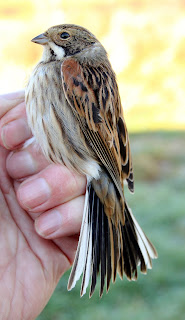At the moment we are stuck in one of those peculiarly nasty spells of dull, wet, British weather that just goes on for ever; I can’t get out ringing, the leaden grey skies preclude any photography and the constant rain means any birding is cut short or restricted. Despite all those obstacles I did get out for an hour or two this morning but it ended when I had to come back home via a tortuous detour through the Lancaster City traffic when the powers that be closed the Cockerham Road for resurfacing. It never rains but it pours.
Wheel Lane at Pilling was partly flooded again this morning, but I drove through at 10mph so as not to create a wave of water that might flood through nearby front doors. The geese came and went from the stubble as noisily as ever, but I stopped only for the Whoopers, 125 of them. From Lane Ends I later saw another 20 or so birds far out on the marsh to bring my total to 145 Whooper Swans for the session. I was early enough for the Little Egret roost but they weren’t there, just 2 on the marsh, the remainder having spent last night at one of their other roosts at either Preesall or Cockerham or elsewhere.
I got to Conder Green because the road was open at that time, it was only later that I had to choose between a full day of the pleasures of Glasson Dock or a return via Lancaster.
I got nice views of 2 Goosander, the wariest of wildfowl, and whilst the light wasn’t wonderful, at ISO400 I managed a few distant shots as they sailed along the creek. Not so the Kingfisher, alert as ever as it shot off over the pool when a large wagon pulled into the parking spot. I think it was the same bird I saw a week ago, a female with quite extensive reddish parts of the lower mandible, rather than a male that has a blacker bill.
 Goosander
Goosander Kingfisher
KingfisherThe tide began to run a little, enough to shift a Spotted Redshank, 2 Curlew and just 4 Redshank from the creek, whilst lots of the about 70 Teal floated into view. The pool was pretty much deserted apart from the regular 6 Little Grebe, 1 Wigeon, 1 Little Egret, and a couple of Shelduck that hove into view. Passerines registered as 1 Reed Bunting, 5 Meadow Pipit, and 2 Greenfinch plus the resident Robin that greets everyone from above the screen.
After my unscheduled visit to Lancaster I made my way down still accessible Hillam Lane to Bank End where the fairly high tide had pushed stuff closer, but by no means up to the road itself. From here I counted 145 Redshank, 38 Curlew, 40 Wigeon, 60 Dunlin, 22 Teal, 32 Shelduck, 1 Grey Heron and 9 Little Egret.
There was a flock of mainly Chaffinch along the hedgerow, with quite a lot of “pinking” and watchful birds in the tops of taller trees, and although I saw a Kestrel I don’t think it was that the 50+ Chaffinch worried about. Along here I also counted 11 Tree Sparrows, 4 Skylark, 2 Meadow Pipit, 1 Reed Bunting and 1 Pied Wagtail.
 Chaffinch
ChaffinchIt was quite a good couple of hours really, and just a pity about the ghastly weather. But I’m determined to enjoy what little birding there is at the moment, and as Betty Smith the American writer once advised on staying positive, with a particularly apt quote for birders and listers alike, “Look at everything as though you were seeing it either for the first or last time”.










































































